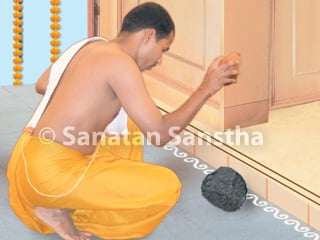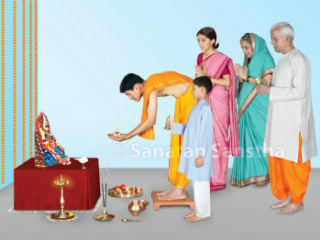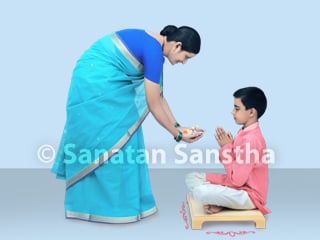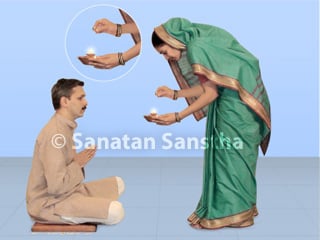1. According to hindu culture how to do inaguration of new shop or likewise things?
2. How to celebrate Birthday according to Hindu culture?
3. What is Importance of Tulsi in Hindu culture?
4. Do you have any information on rituals after childbirth? For e.g. why do we wait over a month before taking baby for darshan etc?
First 1.5 months after the birth, the child is very sensitive and can absorb the frequencies in external environment very easily. The child has very less impressions on its subconscious mind. Therefore it is not advisable to bring him / her to outside world during initial period. The first place to take the child is to temple to give it a divine protective sheath.
The mother, after the delivery of the child, also becomes very sensitive internally. Her menstrual periods stop after 15-20 days but even after that she remain sensitive for few weeks. She is susceptible to attacks from negative energy due to this. Hence for mother also, it is not advisable to go into external environment for 1-1.5 months after delivery.
5. Can you please advise me on the use of a three wick Ghee Lamp? I recently was given one as a gift and I was wondering is it was suitable for worshipping Bhagavan? Do you know why lamps are made with three places for wicks?
As per dharma shastra we should use single wick (preferable) or 5 wick lamp. If we have a 3 wick lamp, instead of not using that lamp we can use only 1 wick out of the 3 wicks for lighting the lamp. Also more important than number of wicks is the Spiritual emotion (bhav) while doing upasana.
Altough lamp with 3 wicks have no spiritual significance, the particular lamp may have been manufactured for beautification from worldly point of view.
As per spirituality odd number is important therefore it is a practice to have lamp with 5 wicks or 1 wick. From this point of view too the above lamp could have been made with 3 wicks.
Lamp with 1 wick denotes oneness with God and with 5 wicks denotes duality. Finally bhav is utmost important than the number of wicks used.
6. During the Thread ceremony, the Brahamchari asks for ‘Bhiksha‘ from his mother, father, relatives & well wisher. Is there any rule that the person, who will offer ‘Bhiksha‘ to Brahamchari, has to be a Brahmin or must marry a Brahmin (for ladies only)?
It is not necessary that the the person (from whom Bhiksha is to be obtained) needs to be brahmin, he/she can be non-brahmin too.
7. How to perform sith day puja of goddess in navratra? What is the significance of sith day? I have been advised by an astrologer to perform sixth day puja as an utpata yoga exists in my chart?
Looking at the patrika and doing the puja etc based on a particular yog gives a person a mental relief and since he / she believes in it he/she performs the act with complete faith.
However one should live in present and leave rest on God. Since we don’t know what is going to happen tomorrow or even in the next moment, there is always a curiosity and interest in living. If He discloses it then there there is no suspense. By performing correct sadhana, and by listening to one’s Guru one can become a Sadhak and thereby one can sustain in difficult times and even change one’s future.
8. How important it is to name a daughter according to moon sign (rasi) in todays age. what are the implications if one chooses a name outside the rasi?
Frequencies (spandan) of the name choosen as per the Rashi letter matches the prakruti of the baby. Choosing any other name might not suit the prakruti of the baby.
Also refer to following article sections:
https://www.hindujagruti.org/hinduism/knowledge/article/why-are-specific-sanskars-performed-after-birth-of-a-child.html#23
https://www.hindujagruti.org/hinduism/knowledge/article/why-are-specific-sanskars-performed-after-birth-of-a-child.html#24
Just as a child’s sex is decided in the womb, so is its name. A sound, touch, form, taste and odour coexist. Hence a child’s name corresponds to its appearance. Only one is unaware of it. Only the spiritually evolved know the matching name. If one cannot get advice from a spiritually evolved person the science of astrology can give guidance on the suitability of the name.
9. Can we water the bath-water to the tulsi plant? I heard that it is not good to offer the water to tulsi used for bath of god-godess idol.
We can pour the bath water of deity idols (collected in the platter) in the tulsi plant, except the Nirmalya.
10. Could you please advise why there is a restriction on the use of tulsi leaves in Ganesh puja?
One of the objectives of ritualistic worship is that the idol which is to be worshipped should get charged with divine consciousness (chaitanya) and that it should help one in making spiritual progress. In order to generate that divine consciousness, the substance which is offered to that idol has more ability to attract the pure particles (pavitrakas) [most subtle spiritual particles] of that deity, from as far as the maha region as compared to other substances. Red flowers have the ability to attract the pure particles of Ganapati, bel of Shankar, tulsi of Vishnu, etc. Hence tulsi leaves are offered to Vishnu. A tulsi plant is planted on a pedestal in front of the house and tulsi is even wedded to Krushna.
Offering tulsi to Ganapati is prohibited because Ganapati mostly favours devotion with expectation (sakam bhakti) while tulsi denotes detachment (vairagya). Thus devotees of Ganapati would not even grow tulsi plants in their compound unlike most Hindus.
Please visit: https://www.hindujagruti.org/hinduism/festivals/ganesh/rituals.php for more details.
11. What is significance of “Achaman“, and related shlokas, Significance of “Naivedya“, how to offer and related shlokas for the same. How and when to change “Yagnopavit“? How many times to chant the “Gayatri Mantra“
1. Achaman is done for internal purification of self before starting puja. By doing bath only external purification is already achieved. The 24 names of Vishnu are chanted followed by few other mantras e.g. gayatri mantra.
2. Offering sacrament (naivedya) to a deity pleases Superior deities, deity of premise and deity of a place faster. Also, any food that we consume is obtained by the grace of God. Hence it is a practice to offer food to God and pay gratitude before consuming it (so that we obtain His chaitanya while consuming it). We pay the obeisance along with 5 vayus (pran, apan, vyan, saman, udan) present in us to the deities while offering naivedya.
3. Yagnopavit is changed during Shravani (in Shravan month). There is a specific mantra which is chanted and also the gayatri mantra is chanted 108 times. It can also be replaced when the existing one breaks.
One can refer to the book for ritualistic worship for the respective mantras and how to chant them.
12. Sometimes after praying the burning lamps turn black at the time of extinguishing! Why does this happen? I pray everyday with diyas lighted in front of deities but it so happens that on rare occasions the diyas turn black, though I use the same oil/ghee and wick every time. I have also noticed that they turn black after burning when I do special mantra jaap as an astrological remedy! What is the reason for this?
As the flame of the lamp is related to the fire element it immediately responds to the vibrations in the environment. Whenever you pray with devotion, the negative forces in the vastu (premise) attack you in order to prevent you from getting the blissful vibrations. The process of the lamp turning black is seen as the result of this attack. The same reason applies when the pooja occurs with devotion.
As your vibrations and the vibrations in the vastu are same, whenever there is argument at your workplace or outside, the lamp turns black due to the attack on you. The remedy for this is to increase the satvik component in your vastu by sprinkling cow urine (Gomutra), burning incense sticks, blowing holy ash (vibhuti) in the morning and evening, playing the God’s chant in the house and increasing one’s spiritual practice. As the satvik component in the vastu increases, you will be purified.
13. I regularly light a single wick ghee lamp at home. I use long cotton wicks and I find that when I light the ghee lamp, all the ghee is used up however, the wick is not fully used up and I tend to push the wick up so that the wick can be fully used up. Should the wick be fully used up and if not, can I re-light the wick the next following day?
The wick in ghee lamp need not be used up fully. You can re-light the wick the next following day. You can move the wick up to the top of the lamp.
14. How to identify the two types of shankas (Vamavarta and Dakshinavarta), one being used to blow and other for puja rituals?
Vamavarta Conch: When we hold the conch in our hand with the part through which it is to be blown facing us and if the inward curving portion of the conch is towards left (anti-clockwise), then it is called as Vamavarta conch. This conch is easily available.
Dakshinavarta Conch: When we hold the conch in our hand with the part through which it is to be blown facing us and if the inward curving portion of the conch is towards right (clockwise), then it is called as Dakshinavarta conch. This conch is rare.
Both Vamavarta and Dakshinavarta conches can be used for blowing during puja ritual.
Female Conch: The curves on the surface of this conch are irregular. Negative energies are attracted when this type of conch is blown. Therefore, it should neither be blown nor used in puja ritual.
15. What happens when a person dies and leaves idols, used for daily worship, to his or her heirs? What if the heirs don’t want them? The person may not want the idols to be sold. Are they supposed to be placed in a river where the ashes of the deceased person are scattered? What happens if more than one child wants the sacred murthis?
If the deities idols are installed by parents and children do not want them then they can either immerse them in water or give it to a temple. In case of the idols which are part of the Family tradition (Kulaparampara) which has been carried forward then immersion or giving to temple is not possible. In case of more than one child wants the sacred idols then they have to decide among themselves who will keep them
16. Recently in our building society a rule is being passed to remove all the plants being kept in window grills. I respect my Tulsi plant and worship it daily. I cannot keep it downstairs in the vehicle parking space and worship it there. Please guide me on this.
You can keep the Tulsi pot in your house saying that it is not a plant but God which you worship everyday and it is not practical for you to go down everyday. Before doing this you can pray to Sri Krushna to help you and guide you.
17. On the Pournima day I had kept green coconut, with a stick attached to it, on the kalash. Today I find the that the stick has detached from green coconut on its own. Please tell me, is this auspicious or inauspicious?
It does not have any spiritual base. So you need not worry.
18. In the article on Rangapanchami the paragraph on celebrating holi in traditional way mentions about worshipping Holika. How can one worship Holika and burn it later? Holika was sister of Hirankashipu and a demoness, therefore how can one worship her for creating a sattvik atmosphere?
Just as we worship the dead body before its cremation and offer obescience so also before burning the demoness Holika we worship her and by saying ‘Holikaay Namah‘ then we light her.
19. Should punchagavya abhishek be performed on Shivling?
Panchagavya abhishek should not be performed on Shivling, however panchamrut abhishek can be performed.
20. Where should we place Panchmukhi Hanuman in our house?
There is no need to keep Panchmukhi Hanuman in the house unless adviced by some spiritual authority and it is to be kept in the place suggested by him.
21. I do meditate daily and would like a ghee lamp for my meditation practice. Would this be safe? Can I use oil in the same lamp if I am out of ghee? I presently use candles for meditation.
Read more about ritualistic worship at Why is ghee lamp preferred to oil lamp during puja ritual?. Lamp is better than candles and ghee is better then oil.
22. When does one install idols of deities? When should the debt of idol be fully paid? Can you do pratishthapana of idol without paying for it? How can you deny payment for idol you have purchased?
Installation of an idol: You can bring home an idol of any Deity and install it; however when it is to be installed in society it requires a spiritual basis. If a Deity through a dream tells a devotee ‘install my idol at so-and-so place’ then he can fulfil the request. A Deity appears before some devotees and tells them, ‘I am buried in the ground in so-and-so place. Take me out from there and install me’. Here too the idol of the Deity can be installed. If a Saint instructs to install an idol of a Deity then also the idol can be installed. Contrary to this you should not install the idol of a Deity just because you felt like doing so, because it does not endow spiritual benefit to society. If you happen to take a loan for installation of an idol then a promise to repay it honestly should be made. Refusing to repay such a loan amounts to cheating. That will not endow the benefit of installation of the idol.
23. Can a female wear a locket with Shri Hanuman’s picture, provided she maintains absolute discipline of celibacy, non consumption of meat, alcohol etc. Will this give her protection from all negative people and negative vibrations around her?
A female can wear a locket with Shri Hanuman’s picture. This only is not enough to give protection from negative vibrations. For obtaining protection from negative vibrations one has to do spiritual practice regularly and by putting full efforts with bhav i.e. with spiritual emotions.
24. Where should we place a picture of Punchmukhi Hanuman inside the house?
Has this been advised to you by anybody then the person will also tell you the place? Otherwise there is no need to keep and if at all you have to keep then you can keep along with the other deities. Read more detail at How should one arrange deities in the temple at home?
25. Is giving milk to Naag Devata appropriate? Can you please provide guidance on this?
Offering of milk to Naag is part of ritual. Naag does not drink milk. Shiv tatva is present in Naag. Bhagvan Shiva likes milk. The abhishek of milk is offered to Shivpind, hence milk is offered as naivedya to Naag.
26. I think that Silk saris should not be offered to Goddess because silk is obtained by boiling silk worms. This is against the principle of ahimsa (non violence) towards other living beings. It is better to only offer cotton since this is a plant and does not suffer when turned into a sari. Please clarify.
-
As its duty, the silkworm is born to sacrifice its life to produce silk (from which cloth is prepared) for others.
-
The saliva in its mouth is enriched with the Sattva component that arises from the Apatattva (Absolute Water Principle). When the silk cocoon is being woven between two threads, there Vayutattva (Absolute Air Principle) enriched Divine vibrations congregate, which enhance the sattvik nature of silk further.
-
The saliva in its mouth (enriched with the Sattva component) produces silk-like threads. Thus, by its sacrificing its life the silkworm performs its duty of creating Sattva component religiously. That is why, through this action its spiritual practice gets performed and others too obtain silk enriched with the Sattva component.
-
When bringing a jiva (Embodied soul) into this world, the mission that it is supposed to perform in its birth is predetermined by the Creator of the universe; that is, its duties are predecided. Based on this rule, the cycles of creation to sustenance and dissolution of the universe continue uninterruptedly.
-
When an organism is created, its dissolution is also decided. Hence, who is supposed to sacrifice what is also predecided by the laws of the universe. Therefore, killing the silkworm is not a part of choice for the worm; it is a Divine duty.
-
Since the purpose of creation of the silkworm is to create silk cloth, producing silk by killing it is not a sin; on the contrary, if silk threads are obtained by killing it then it amounts to a Divine act.
-
If a silkworm leaves its silk cocoon, then ants and pests feast on the silk threads left behind.
-
The worm too is killed by birds of prey such as kites, crows etc., because after leaving the cocoon the specific odour its body emits attracts these birds.
-
Thus, the worm dies and the silk it has woven is also destroyed. This process generates a sin since it leads to decrease in the Sattva component.
-
Therefore, it is better to kill the silk worm and use the silk for a Divine cause. At least then it spiritually uplifts the silk worm because its purpose of life, of creating silk, is accomplished. That is why, instead of dying, by getting killed in this way the purpose of its life is fulfilled and according to the laws of Dharma this act is not sinful.
(Through the medium of Mrs. Anjali Gadgil, Adhik Vaishakh Krushna Trayodashi, Kaliyug Varsh 5112 [12th May 2010], 2.01 p.m.)
27. What are the 108 names of Lord Datta?
The 108 names of Lord Datta are: Shri Dattatreya Ashtotarra Shatanamavali (to be read on Thursday’s)
Om Anasuya-sutaya namah
Om Dattaya namah
Om Atri-putraya namah
Om Maha-munaye namah
Om Yogeendraya namah
Om Punya-purushaya namah
Om Deveshaya namah
Om Jagadeeshwaraya namah
Om Paramatmane namah
Om Parasmai-bramhane namah
Om Sadanandaya namah
Om Jagad-guruve namah
Om Nitya-truptaya namah
Om Nirvi-karaya namah
Om Niranjanaya namah
Om Gunatmakaya namah
Om Gunatitaya namah
Om Bramha-vishnu-shiva-tmikaya namah
Om Nana-rupadharaya namah
Om Nityaya namah
Om Shantaya namah
Om Dantaya namah
Om Krupanidhaye namah
Om Bhakti-priyaya namah
Om Bhava-haraya namah
Om Bhagavate namah
Om Bhava-nashanaya namah
Om Aadi-devaya namah
Om Maha-devaya namah
Om Sarveshaya namah
Om Bhuwaneshwaraya namah
Om Vedantha-vedyaya namah
Om Varadaya namah
Om Vishwa-rupaya namah
Om Avyayaya namah
Om Haraye namah
Om Sachitanandaya namah
Om Sarveshaya namah
Om Yogeeshaya namah
Om Baktha-vatsalaya namah
Om Digambharaya namah
Om Divya-murtaye namah
Om Divya-bhoti-vibushanaya namah
Om Anadi-siddaya namah
Om Sulabaya namah
Om Bhaktha-vanchita-dayakaya namah
Om Ekasmai namah
Om Anekaya namah
Om Advitiyaya namah
Om Nigha-magama-vanditaya namah
Om Bhukti-mukti-pradatre namah
Om Karya-veerya-vara-pradaya namah
Om Shaswatangaya namah
Om Vishuddhatmane namah
Om Vishwatmane namah
Om Vishwato-mukhaya namah
Om Sarveshwaraya namah
Om Sada-tustaya namah
Om Sarva-mangala-dayakaya namah
Om Nish-kalankaya namah
Om Nira-basaya namah
Om Nirvi-kalpaya namah
Om Nirish-rayaya namah
Om Purushottamaya namah
Om Lokanadaya namah
Om Purana-purushaya namah
Om Anaghaya namah
Om Apara-mahimne namah
Om Anantaya namah
Om Aadyamta-rahita-krutaye namah
Om Samsara-vanada-vagnaye namah
Om Bhava-sagara-tarakaya namah
Om Shreenivasaya namah
Om Vishalakshaya namah
Om Kshirabdhi-shaya-naya namah
Om Achyutaya namah
Om Sarva-papakshaya-karaya namah
Om Tapatraya-nivaranaya namah
Om Lokeshaya namah
Om Sarva-bhooteshaya namah
Om Vyapakaya namah
Om Karunamayaya namah
Om Bramhadi-vamdita-padaya namah
Om Muni-vandyaya namah
Om Stuti-priyaya namah
Om Nama-rupa-kriyatitaya namah
Om Nispruhaya namah
Om Nirmalatmakaya namah
Om Mahadeeshaya namah
Om Mahatmane namah
Om Maha-devaya namah
Om Maheshwaraya namah
Om Vyagra-charmambara-dharaya namah
Om Naga-kundala-bhushanaya namah
Om Sarva-lakshana sampoornaya namah
Om Sarva-siddi-pradaya-kaya namah
Om Sarva-gynaya namah
Om Karuna-simdhave namah
Om Sarpa-haraya namah
Om Sada-shivaya namah
Om Sahyadri-vasaya namah
Om Sarvatmane namah
Om Bhavabandha-vimochanaya namah
Om Vishwambaraya namah
Om Vishwanadhaya namah
Om Jagannadhaya namah
Om Jagathprabhave namah
28. Why is it that women should not apply kumkum to her forehead after the death of their husband? Mangal sutra is tied by the husband, hence after his death it can be removed. But a women may be applying kumkum from her childhood. Also in the article it has been clearly mentioned that wearing kumkum is to remove the negative vibrations from body. Does it mean that if a man dies his wife has to suffer in negative energy by not wearing the kumkum? Please clarify.
Kumkum is the substance which activates the Shakti (energy) in a woman. As long as the husband is alive, there exists an inseparable bond between the husband and wife on the physical plane. After the death of the husband as the physical relationship with the spouse culminates, so does the need for the Shakti Principle. If a widow applies kumkum, then the amount of activated Shakti in her increases. After the death of her husband her only duty as a wife is to sacrifice everything and merge into Shiv. If she does not apply kunkum, then the amount of manifest energy remaining unmanifest in her is more and her further progress is hastened, that is, she is able to develop detachment through this unmanifest energy. When a widow applies kunkum she always remembers her husband and hence he is forced to return to the earth. This hampers his subtle body from attaining gati (status after death). The rationalist widows of today continue to apply kunkum saying, “So what if the husband is dead ?” This action may cause their late husbands and consequently them, a loss on the spiritual level. So instead of using your intellect follow the norms of Dharma meticulously believing that ‘following ritualistic, scientific sanskars (subconscious impressions) stipulated in the Hindu Dharma are meant for human welfare.’ Politicians from the Congress Party like Janardan Pujari make an intellectual farce only to seek publicity but in reality they are going against Dharma. O Hindus protest vehemently against such anti-Hindu moves, but in a peaceful manner. -Editor

 Why inauguration ceremony should be done by breaking a coconut ?
Why inauguration ceremony should be done by breaking a coconut ? Performing Aarti
Performing Aarti Spiritual birthday
Spiritual birthday Ritual of waving a lit lamp (Aukshan)
Ritual of waving a lit lamp (Aukshan) Namaste
Namaste
Please help… Can i buy flowers a day before in the evening n keep them packed in polythene to use them next day in the morning for pooja